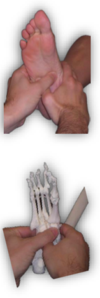Lab 9: Ankle and Foot Treatments OSCE Flashcards
Distal Fibular Anterior ART
How do you perform this test?
Patient: Supine
Physician: Stand/Sit at the foot of the table
- Stabilize patient’s foot, wrapping fingers around calcaneus and engage dorsiflexion restrictive barrier.
- Thumb of lateral hand contacts the anterior aspect of the distal fibula with other thumb on top.
- Engage the restrictive barrier and using articulatory technique until motion improves.
- Reassess TART

Distal Fibular Posterior ART
How do you perform this test?
Patient: Prone
Physician: Stand/Sit at the foot of the table
- Stabilize patient’s foot, wrapping fingers around calcaneus and engage plantarflexion restrictive barrier.
- Thumb of lateral hand contacts the posterior aspect of the distal fibula with other thumb on top.
- Engage the restrictive barrier and using articulatory technique until motion improves.
- Reassess TART

Dorsiflexed Talus SD MET
How would you perform this treatment?
Patient: Supine
Physician: Stand/Sit at the foot of the table
- Grasp patient’s ankle with one hand at the level of the malleoli. Other hand is placed over the dorsum on the patient’s foot.
- Bring the patient’s foot into the plantar flexion restrictive barrier
- Activating Force: Patient is instructed to bring their foot into dorsiflexion against isometric resistance for 3-5sec then isometric relaxation.
- Engage a new barrier & repeat until no new barriers are met.
- Reassess TART

Plantarflexed Talus SD MET
How would you perform this treatment?
Patient: Supine
Physician: Stand/Sit at the foot of the table
- Grasp patient’s ankle with one hand at the level of the malleoli. Other hand is placed on the plantar surface of the patient’s foot.
- Bring the patient’s foot into the dorsiflexion restrictive barrier
- Activating Force: Patient is instructed to bring their foot into plantarflexion against isometric resistance for 3-5 sec then isometric relaxation.
- Engage a new barrier & repeat until no new barriers are met.
- Reassess TART

Talus Eversion and Iversion SD ART
How would you perform this treatment?
Patient: Seated with leg hanging off table
Physician: Sitting at foot of the table
- Grasp patient’s heel with one hand and grasp the talus & dorsum of the foot with the other.
- Maintain traction on calcaneus and articulate inversion and eversion with a “figure 8” maneuver until no new
restrictive barriers are met or quality of ROM normalizes. - Reassess TART
- Talus Eversion with anteromedial glide*
- Talus Inverstion with posterolateral glide*

Everted Cuboid, Inverted Navicular, Cuneiform with Plantar Glide SD MET
How would you perform this treatment
Patient: Supine/seated
Physician: Sitting at the foot of the table
- Grasp patient’s foot with both hands on dorsum of foot, lifting the foot off the table and dorsiflex to engage restrictive barrier.
- Adjust accordingly with inversion/eversion and dorsiflexion/plantarflexion.
- Cross thumbs on plantar surface with one pad on cuboid & other on navicular with a separating force.
- Instruct patient to “Push your foot into my thumbs” & maintain a counterforce for 3- 5 seconds until no new restrictive barriers are met.
- Reassess TART

Dorsal/Plantar Glide of Cuneiform/Metatarsal Joint SD ART
How would you perform this treatment?
Patient: Supine/seated
Physician: Sitting at the foot of the table
- Isolate joint between fingers.
- Engage barrier, alternating between restrictive barrier and ease of motion until normal physiologic motion is restored.
- Reassess TART

Dorsal/Plantar Glide of MTP/PIP Joint SD ART
How would you perform this treatment?
Patient: Supine/seated
Physician: Sitting at the foot of the table
- Isolate joint between fingers.
- Engage barrier, alternating between restrictive barrier and ease of motion until normal physiologic motion is restored.
- Reassess TART.



